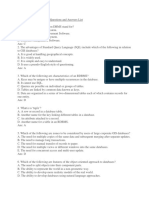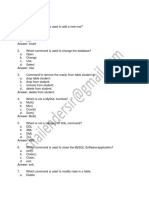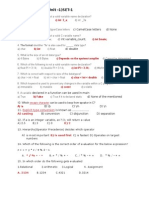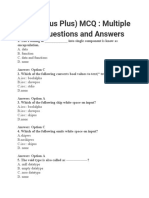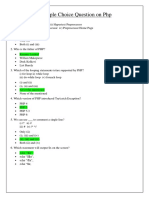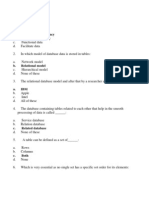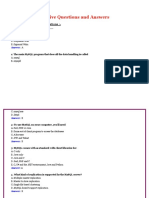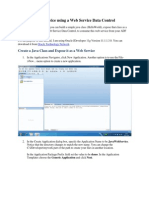100%(3)100% found this document useful (3 votes)
2K viewsMCQ On MySQL
The document contains 25 multiple choice questions about MySQL. Some key points covered are:
- The "father" of MySQL is Michael Widenius.
- MySQL supports master-slave replication.
- The USE command is used to choose the database you want to use once connected to MySQL.
- DISTINCT is used to remove duplicate rows from a SELECT result set.
- ALTER TABLE is used to add a new column to an existing table.
- DROP TABLE is used to delete an entire MySQL table.
Uploaded by
SonaboseCopyright
© © All Rights Reserved
Available Formats
Download as PDF, TXT or read online on Scribd
100%(3)100% found this document useful (3 votes)
2K viewsMCQ On MySQL
The document contains 25 multiple choice questions about MySQL. Some key points covered are:
- The "father" of MySQL is Michael Widenius.
- MySQL supports master-slave replication.
- The USE command is used to choose the database you want to use once connected to MySQL.
- DISTINCT is used to remove duplicate rows from a SELECT result set.
- ALTER TABLE is used to add a new column to an existing table.
- DROP TABLE is used to delete an entire MySQL table.
Uploaded by
SonaboseCopyright
© © All Rights Reserved
Available Formats
Download as PDF, TXT or read online on Scribd
You are on page 1/ 3
Multiple Choice Question on MySQL
1. The “father” of MySQL is ______.
Michael Widenius
Bill Joy
Stephanie Wall
Sigmund Velin
2. What kind of replication is supported by the MySQL server?
Multiple-master replication
Master to slave replication
Single file based clustering
MySQL doesn’t support replication
3. Internally information is held in tables. Which of these is NOT a valid format:
BDB
Isam99
MyIsam
InnoDb
4. MySQL supports the complete SQL99 standard
True
False
5. In a LIKE clause, you can could ask for any value ending in “ton” by writing
LIKE ton$
LIKE ^.*ton$
LIKE %ton
LIKE *ton
6. The USE command
Is a pseudonym for the SELECT command
Has been deprecated and should be avoided for security reasons
Should be used to choose the database you want to use once you’ve connected to MySQL
Is used to load code from another file
7. MySQL Access security is controlled through
MySQL login accounts, and privileges set for each account.
The ID that the user logged into the server through, and privileges set up for that account.
A table of valid IP addresses, and privileges set up for each IP address
The normal login security is sufficient for MySQL, and it does not have any extra controls of
its own.
8. If you want to undo a GRANT, you should use
REVOKE
UNDO
UNGRANT
DELETE
9. How many distinct, different values can you hold in an enum field?
255
7
65535
2 (True and False)
10. Which of the following is NOT available in MySQL:
REVOKE
FETCH
LIKE
SELECT
11. Which of these field types would be best to hold a .jpg image?
char binary
nchar binary
text
blob
12. What’s the difference between the DESCRIBE and SHOW FIELDS FROM commands?
Only SHOW FIELDS FROM can take a LIKE clause
Nothing – they’re the same thing
Only DESCRIBE can take a LIKE clause
13. Which of the following is available in MySQL:
CREATE TRIGGER
CREATE SCHEMA
CREATE DATABASE
CREATE VIEW
14. To remove duplicate rows from the result set of a SELECT use the following keyword:
NO DUPLICATE
UNIQUE
DISTINCT
None of the above
15. How much character are allowed to create database name?
55
72
64
40
16. In a SELECT query with a GROUP BY clause, a WHERE clause, and a HAVING clause, the
WHERE conditions are applied before the HAVING conditions.
True
False
Either True or False
None of the above
17. Which command returns current version on MySQL?
SELECT MySQLVERSION();
SELECT VERSION(“MySQL”);
SELECT VERSION();
All the above
18. Which clause is used to sort the result of SELECT statement?
SORT BY
ORDER BY
ARRENGE BY
None of the above
19. Which data types are treaded as arrays
Integer
Float
String
Booleans
20. In order to add a new column to an existing table in SQL, we can use the command
MODIFY TABLE
EDIT TABLE
ALTER TABLE
ALTER COLUMNS
21. Which of the following ways below are the correct way to get the current date?
SELECT CURTIME();
SELECT CURDATE();
SELECT CURRRENT_TIME()
All of the above.
22. Which of the following is used to delete an entire MYSQL database?
mysql_drop_database
mysql_drop_entiredb
mysql_drop_db
mysql_drop_dbase
23. In a LIKE clause, you can ask for any 6 letter value by writing:
LIKE??????
LIKE .{6}
LIKE ^.{6}$
LIKE ______ (that’s six underscore characters)
24. Which of these is a valid call to a function (watch the spaces carefully!)
CONCAT( A , B )
CONCAT( “A” , “B” )
CONCAT ( “A” + “B” )
CONCAT (A, B)
25. Which of these commands will delete a table called TEST if you have appropriate authority:
DROP TEST
DELETE TEST WHERE confirm = “YES”
DROP TEST WHERE confirm = “YES”
DROP TABLE TEST
You might also like
- Aggregate Functions Questions and AnswersNo ratings yetAggregate Functions Questions and Answers57 pages
- Kerala PSC HSST Computer Science Model Question100% (1)Kerala PSC HSST Computer Science Model Question7 pages
- 200 Real Time Java Multiple Choice Questions and Answers - Mcqs100% (2)200 Real Time Java Multiple Choice Questions and Answers - Mcqs34 pages
- ALV Grid Display With Checkbox To Process Selected Records at RuntimeNo ratings yetALV Grid Display With Checkbox To Process Selected Records at Runtime20 pages
- 100 Top Computer FUNDAMENTAL Questions: and Answers0% (1)100 Top Computer FUNDAMENTAL Questions: and Answers22 pages
- SQL MCQ (Multiple Choice Questions) - JavatpointNo ratings yetSQL MCQ (Multiple Choice Questions) - Javatpoint26 pages
- 55 TOP PHP MULTIPLE CHOICE QUESTIONS AND ANSWERS PDF - REAL TIME Interview QuestionsNo ratings yet55 TOP PHP MULTIPLE CHOICE QUESTIONS AND ANSWERS PDF - REAL TIME Interview Questions17 pages
- Database Management System: Multiple Choice Questions & Answers100% (1)Database Management System: Multiple Choice Questions & Answers7 pages
- Javascript Multiple Choice Questions and Answers-Sheet 1No ratings yetJavascript Multiple Choice Questions and Answers-Sheet 1276 pages
- C++ (C Plus Plus) MCQ: Multiple Choice Questions and Answers100% (4)C++ (C Plus Plus) MCQ: Multiple Choice Questions and Answers10 pages
- Visual Basic Programming Question Paper For InstituteNo ratings yetVisual Basic Programming Question Paper For Institute8 pages
- C Multiple Choice Questions and Answers MCQ With AnsNo ratings yetC Multiple Choice Questions and Answers MCQ With Ans11 pages
- Ellipse: Superior Planning, Management and Optimization of Next-Generation Backhaul NetworksNo ratings yetEllipse: Superior Planning, Management and Optimization of Next-Generation Backhaul Networks4 pages
- Agile: Profibus Communication Manual Frequency Inverter 230V / 400VNo ratings yetAgile: Profibus Communication Manual Frequency Inverter 230V / 400V8 pages
- Method of Procedure For MCPA Power SavingNo ratings yetMethod of Procedure For MCPA Power Saving6 pages
- Wireframe Model (2D in 1960s For Drafting, 3D in 1970s) Wireframe EntitiesNo ratings yetWireframe Model (2D in 1960s For Drafting, 3D in 1970s) Wireframe Entities27 pages
- 13the Role of ChatGPT in Language TranslationNo ratings yet13the Role of ChatGPT in Language Translation2 pages
- The Complete Beginner Guide To FreelancingNo ratings yetThe Complete Beginner Guide To Freelancing13 pages
- HAC - Pentest Solutions Brief HackerOne - L1R7 RGBNo ratings yetHAC - Pentest Solutions Brief HackerOne - L1R7 RGB2 pages
- Instant Download Smart Textiles Fundamentals Design and Interaction 1st Edition Stefan Schneegass PDF All Chapters100% (1)Instant Download Smart Textiles Fundamentals Design and Interaction 1st Edition Stefan Schneegass PDF All Chapters65 pages
- MISP Best Practices in Threat IntelligenceNo ratings yetMISP Best Practices in Threat Intelligence11 pages

